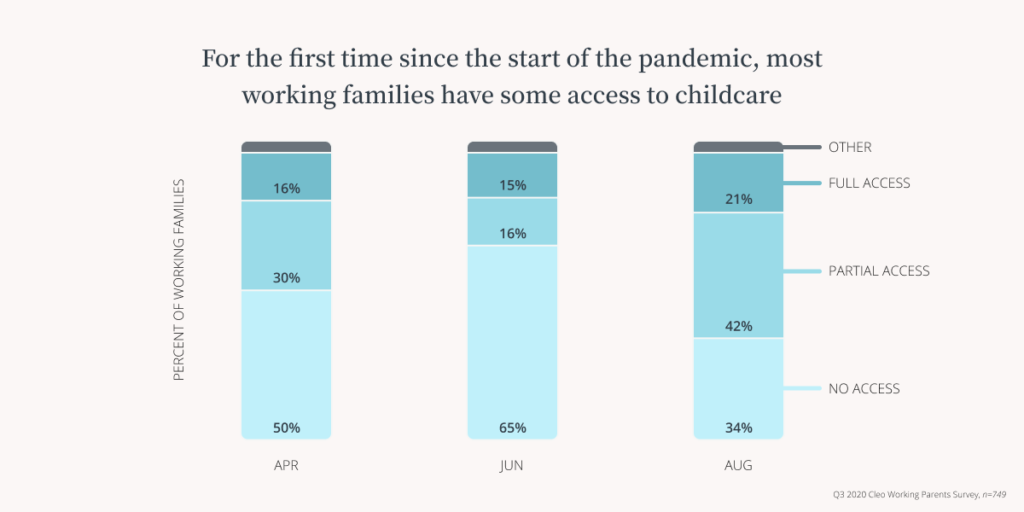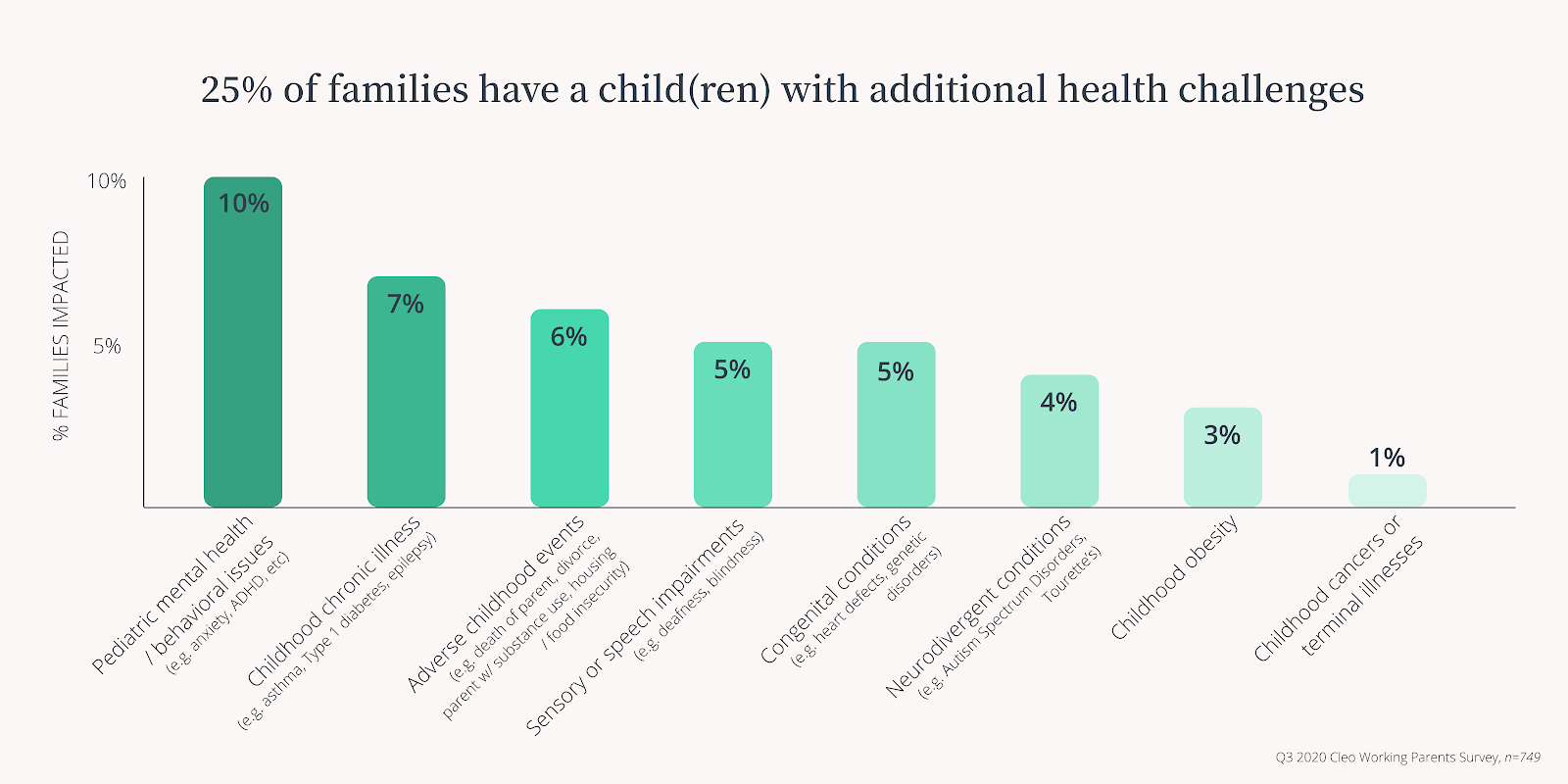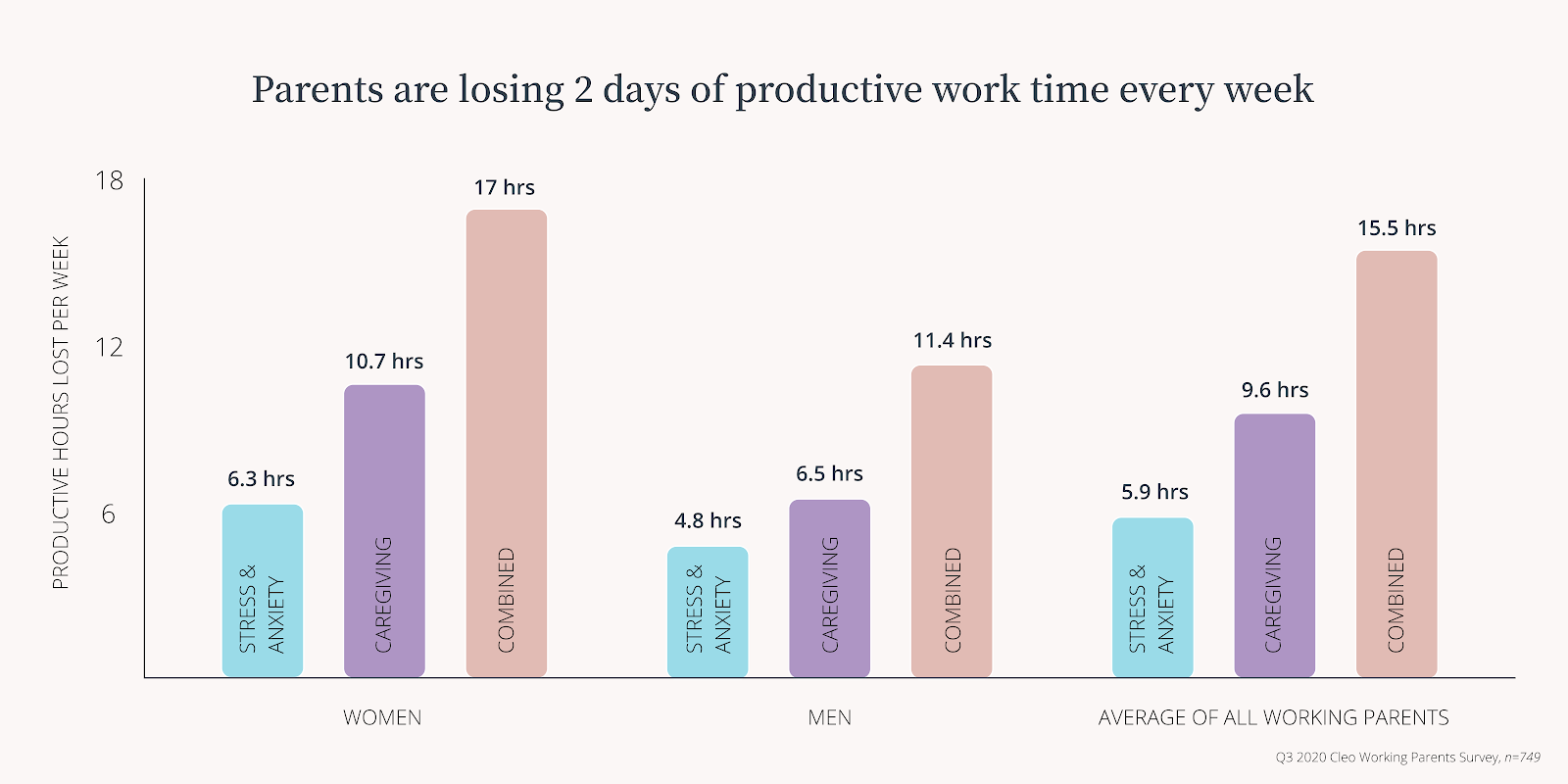Since the beginning of the national shutdown, we’ve surveyed working parents to understand the unique problems the COVID-19 pandemic has created for them, how they’re coping with those problems, and how their relationship to working is changing as a result. In April we saw parents facing a childcare crisis, seeking strategies for more support. In June, that crisis became even more pronounced and we saw more parents leaving the workforce.
Over six months into the new world of WFH and remote learning that many parents are living in, we’re starting to see working parents (and their employers) adapt to the new normal. However, adapting to get by day-to-day has real tradeoffs. The pressure to balance work and family has never been stronger, and women are bearing the brunt of it. Stress and the demands of (often) full time caregiving are taking a major toll on working moms’ productivity. Without rapid intervention at the government- or employer-level, working parents, especially working moms, will be left behind and lose decades of progress towards equal representation for women in the workforce.
Our survey uncovered several themes that are critical for employers to watch closely and consider, including the following:
- 61% of women (versus 26% of men) feel responsible for the majority of caregiving and education responsibilities in their partnership
- 1 in 4 families have a child who has specialized health needs, such as mental health/behavioral issues, chronic illness, or neurodivergent conditions
- Working parents in the US are losing a cumulative 720 million hours each week to stress/anxiety and caregiving, with women losing 49% more time than men
- 39% of working parents adjusted their hours with the help of a flexible work schedule, with women 15% more likely to have made this change
- 1 in 4 people are still considering finding a new job to better accommodate their dual role as a working parent
Read the full report below for details on our complete findings.
Caregiving
Since the beginning of the pandemic, lack of childcare support has been one of the most pressing challenges for working families. In June we found that 65% percent of families were without childcare coverage (compared to 50% in April)—with only 15% of families having consistent childcare coverage. 20% had some partial or temporary coverage.
The latest findings from our Q3 2020 survey show that the situation has gotten a bit better for families, but is still far from ideal. As of September 2020,
- 34% of working families are still without childcare coverage
- 42% of families report having had partial coverage or have just recently found a solution to cover their childcare needs
- 21% of families have had a continued childcare solution

Both the husband and I work from home, with only one small office. When the children are here, it is so difficult to structure tasks, take clients call etc. Childcare in the home does not really resolve our issue.
Working other of three children that range in age from 3 - 14 years old
Unfortunately, lack of sufficient childcare support puts additional burden on women. They report that they are often taking on a higher percentage of caregiving and parenting responsibilities when they have a man co-parent.
- 34% of working families are still without childcare coverage
- Women are more than twice as likely as men to say that they handle more than 50% of caregiving and education responsibilities.
- 61% of women and only 26% of men said they are responsible for more than 50% of caregiving and education responsibilities in their partnership
When the pandemic first started my husband worked full time from home while helping the kids with online learning. That couldn’t last. We hired a nanny. I work in healthcare. On my days off when I usually do stuff for the household I now help them with school and I have to do household stuff at other times. It’s very challenging.
Working Mother of Three
Many working parents aren’t just managing a lack of childcare for young children, but are also navigating how to support caregiving and education for their older children. Roughly 75% of families indicated that their child(ren) aged 6 or older is currently doing remote learning and not attending school in person. As parents navigate securing childcare and education, the list of challenges and uncertainties can feel near infinite. The most common challenges we saw reported were:
- Determining whether a program or service has standardized health and hygiene protocols to protect against COVID-19 (most commonly cited challenge)
- Knowing what types of options or services are most appropriate for their child(ren)
- Making the time to investigate different options, including compariting pricing
- Evaluating the quality of a company or service

Parents are now being tasked with taking on responsibilities that many used to outsource to professionals—trained early childhood educators, teachers, and school districts. Concerns about safety mean options that may have worked for families before are no longer viable. That places a burden on parents to do research and explore other options, time most of these parents do not have.
Our school system has allowed parents to choose between two bad options: part-time, irregular hybrid or fully remote. The system has made minimal efforts to improve remote learning or equip families with resources.”
Working mother of three children that range from 3-14 years old
Health and wellness
Many working parents are also under stress related to managing the health of everyone in their households. Concerns about health and safety were the most common challenges reported across all families.
- One in four families have a child(ren) who has specialized health needs.
- 10% of all families report having a child with a pediatric mental health or behavioral issue (e.g. anxiety, ADHD)
- 7% of families report having a child with a childhood chronic illness (e.g. asthma, Type 1 diabetes, epilepsy)
My daughter has asthma and I won’t send her back to in-person school learning until COVID rates go down dramatically.
Working mother of three children

Other caregiving responsibilities
Working parents were asked about other caregiving responsibilities: “Do you have caregiving responsibilities beyond being a parent to a child(ren) (e.g. caregiving responsibilities for a disabled, sick or elderly loved one)?”
- 15% of respondents indicated that they have additional caregiving responsibilities beyond being a parent such as caring for a sick, disabled, or elderly loved one
- 25% of families with a total household income of less than $100,000 have additional caregiving responsibilities for a disabled or elderly loved one
- 12% of families with a total household income of $100,000 or more have additional caregiving responsibilities for a disabled or elderly loved one
We have an elderly parent living in my house. I’m responsible for all her medical and financial needs. She cannot physically help with household chores or schooling of my older teen. I don’t want my teenager back in in-person schooling as he might unwittingly bring COVID home from other kids.”
Working mother of One TEENAGER
Impacting how parents work
Several recent studies have reported on an increased rate of stress and anxiety among American adults during the pandemic. Historically, mental health challenges have impacted work productivity. The pandemic has been referred to as a “mental health crisis for working parents” – working parents are experiencing all of the same anxieties from the pandemic as non-parents, but have added stress and impact on productivity due to their caregiving responsibilities, lack of childcare, and concerns over children’s health and development during this unprecedented time.
Parents are losing time they normally would spend working to things like stress and anxiety about COVID-19 and their day to day caregiving obligations.
- Working parents are losing an average of 1.2 hours to stress and anxiety plus 1.9 hours to caregiving every day
- This translates to 2 full days of lost productive work time every week
- Fewer than 1 in 4 working parents, report losing no time at all due to anxiety or caregiving responsibilities
- Fewer than 1 in 4 working parents, report losing no time at all due to anxiety or caregiving responsibilities
- In particular, women are losing 63% more time to caregiving obligations than men

There are about 46 million working parents in the United States with children under 18 years old, so this loss in productivity is no small hit to the national economy. Taking care of working parents’ mental health and supporting their caregiving needs is not only the right thing to do, it’s good for business and the economy as a whole.
- Working parents in the US are losing a cumulative 720 million hours each week to stress/anxiety and caregiving
- This adds to the whopping sum of $76 billion of GDP lost every week due to decreased productivity among working parents

Challenges related to childcare or remote learning are impacting how many working parents are approaching their work schedule and how much time they can dedicate to work obligations. While we see both men and women making changes to their schedules, overall women were more likely to make adjustments..
- 39% of working parents adjusted their working hours while still working their full hours with the help of a flexible work schedule, with women 15% more likely to have made this change
- 62% of working parents noted that either they or their partner changed their hours (due to a flexible schedule) to better accommodate work and caregiving responsibilities, and held consistent across income levels

The stark reality is, some families were not able to balance their increase in caregiving and parenting responsibilities with their prior work schedule and a number of working parents have either moved to a part-time work schedule or left the workforce altogether.
- 21% of the working parents have either decreased their hours or left their job to take care of their child(ren)
- 34% of respondents noted that either they or their partner had either moved to part-time or left their job to take care of their child(ren). This remains consistent with June (33%)
A higher percentage of women indicated that they are adjusting their work schedules to better balance work and family obligations, but many are also providing near-full-time childcare for their children while continuing to work full-time. This is putting women on a direct path to burnout. A recent McKinsey study found that women’s jobs are 1.8 times more vulnerable to this crisis than men’s jobs, largely due to the pandemic’s effect of increasing the burden of unpaid care, which is disproportionately carried by women. We heard from many women respondents in the Cleo Working Parents survey that while many are “making it work” right now, they may leave their jobs if childcare support or in-person schooling does not get resolved soon.
We Struggle with no daycare and worked in the middle of the night. Then I was told to go back to the office. Trying to find a nanny you trust with no time to interview and trial was hard. A family member…was able to help with childcare. If these things didn’t align, I would be having a harder time and most likely would have quit my job due to no childcare.
Working mother of two children (a toddler and elementary school-aged child)
A number of respondents indicated a shift to remote work has made it somewhat easier to ensure their childcare and caregiving needs are covered, but presents its own challenges of working while parenting. Working parents reported a mix of where they are currently working:
- 21% are working from their company’s physical place of work / office
- 59% are working fully remotely from home
- 14% are working a mix of remotely and at the company’s physical office
I am putting in more hours than I did in the office. I have back to back zoom meetings, then need to tend to lunch for kids, then pump/breastfeed when I can because meetings get scheduled over my blocked time, and then I need time to cook dinner. After the kids are asleep, I’m back online to try to finish my individual work that I was not able to get done because I was in meetings all day.
Working mother of two young children
The role of employers
COVID-19 has not only increased the burden on working parents, but also ignited more conversations about the value of a diverse and inclusive workforce and how to support working parents. If employers weren’t aware before this year, they certainly are now.
One interesting trend we found was an increase in working parents feeling supported by their employers. Respondents were asked whether they agree with the statement, “My organization supports my dual role as a parent and as a professional.”
- In April, at the beginning of the pandemic, only 24% of working parents agreed that their company supported their dual role as a parent and a professional
- Now, six months into the pandemic, this has increased by over 3x to 78% and was consistent across women and men
- 82% of working parents feel comfortable talking to their employer when they are dealing with difficult situations outside of work that may impact their job

My company has been very affirming and empathetic to employees with caregiving responsibilities. This is reflected in their communication at all levels of leadership, as well as the policies and benefits they’ve offered to caregivers since COVID-19 started.
Working father of 3 children, all under 6 years old
Even though a majority of respondents feel supported in a dual role as employee and parent by their employers, approximately 1 in 4 are considering finding a different job that better accommodates their dual role. Respondents were asked whether they agree with the statement, “I am considering leaving my current position to find a position that better accommodates being a parent while working.”
- 27% of all respondents agree to some extent that they are considering a new, more supportive role in September 2020
- In April 2020 only 16% of respondents were in agreement with the statement
While I love my current company and work, it’s not an active family focused/friendly environment. I am considering leaving for a more traditional tech company, with more resources and support.
Working mother of three young children
The reality is, as the pandemic has resumed, working parents have struck an unsustainable balance. Parents are continuing to struggle and the bulk of that struggle is on women. Despite the perceived challenges of supporting working families, if employers want to attract, retain, and engage working parents, there are several strategies that can support working parents now and as our world returns to “normal,” including:
- Flexible schedules & remote work options
- Financial support of childcare and education support services
- Offering family benefits to working parents
For companies to maintain the diverse, inclusive workforces they’ve worked to build, it is imperative they step in to support their working parents. Failing to do so has dire consequences for our economy and for the march towards gender equality.
Methodology
We surveyed 749 working parents with children from newborn to age 18, including Cleo members as well as non-members. Data is aggregated and anonymized. 75% of respondents work full time, 18% part time or contract, 2% currently on leave, and 5% “other.” Survey responses are representative of parents in the United States across cities/states, race & ethnicity, and income levels (~50% had total HH income less than $100,000 and 50% had total HH income above $100,000). We recognize that gender is not binary. 71% of respondents were women, 26% men, and 2% transgender, <1% nonbinary. Data for transgender and nonbinary parents was not statistically significant to report on anonymously. 90% of respondents represent a two-parent, man/woman home. 40% had one child, with 60% having more than one.
National hours lost was calculated using working parent data from the Bureau of Labor Statistics and applying current unemployment rates to estimate total number of working parents. GDP impact was calculated by applying GDP per hours worked in the United States from The Organisation for Economic Co-operation and Development ($106.1) to the total number of hours lost nationally.
